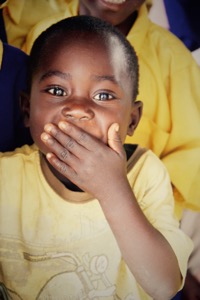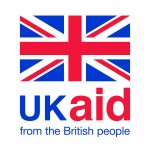6 Months, 6 Schools
We thought that the 6 month Jumpstart! anniversary is a nice opportunity to give you some more information about the schools that we are supporting. This is why, we will provide you with 6 school profiles here. They will be uploaded one by one, so keep your eyes open for facebook posts and tweets and enjoy !
School #1: Welcome to Nwoya Public Nursery School!
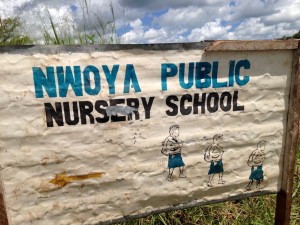 Hidden behind long grass, a nicely hand-drawn sign makes you aware of this little school, located just off a main road in the Nwoya district, in Northern Uganda. The school started 5 years ago and the number of pupils has nearly doubled now, amounting to 63 pupils. All of them are full of energy – hopping around, laughing and talking cheerfully, whether it is while enjoying their cup of porridge or in class.
Hidden behind long grass, a nicely hand-drawn sign makes you aware of this little school, located just off a main road in the Nwoya district, in Northern Uganda. The school started 5 years ago and the number of pupils has nearly doubled now, amounting to 63 pupils. All of them are full of energy – hopping around, laughing and talking cheerfully, whether it is while enjoying their cup of porridge or in class.
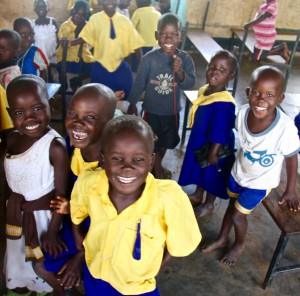 Fortunately, there are two motivated and committed teachers, Doreen and Stephen, and headteacher, Jackeline, who know how to deal with so much energy by keeping the children entertained with lots of dances and inside and outside learning games. Stephen’s micro-innovation of daily morning parades, where students sing songs, perform traditional dances, and narrate stories, was even among the 50 top micro-innovations of the STIR Education’s recent micro-innovation competition. In addition, they are also a good team, happy to enjoy some lunch together and chat after a school day.
Fortunately, there are two motivated and committed teachers, Doreen and Stephen, and headteacher, Jackeline, who know how to deal with so much energy by keeping the children entertained with lots of dances and inside and outside learning games. Stephen’s micro-innovation of daily morning parades, where students sing songs, perform traditional dances, and narrate stories, was even among the 50 top micro-innovations of the STIR Education’s recent micro-innovation competition. In addition, they are also a good team, happy to enjoy some lunch together and chat after a school day.
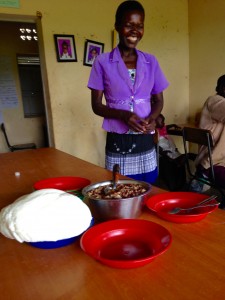 The school has one main building with two classrooms and an office, and a hut for support. However, as there are three levels of nursery (K1, K2 and K3), they have been struggling with having to teach K2 and K3 together in one classroom. As a result, parents decided to get together and built a provisional hut. We are excited to see how our community sensitisation work seems to have initiated a good level of parental engagement: parents also come to clean and tidy the environment around the school once a week, or come together to create learning materials out of local materials such as drid banana skin. Furthermore, they have also appointed a community chairperson for the school and established a Village Saving & Loan Association, from which parents who cannot afford school fees are able to receive loans to pay them.
The school has one main building with two classrooms and an office, and a hut for support. However, as there are three levels of nursery (K1, K2 and K3), they have been struggling with having to teach K2 and K3 together in one classroom. As a result, parents decided to get together and built a provisional hut. We are excited to see how our community sensitisation work seems to have initiated a good level of parental engagement: parents also come to clean and tidy the environment around the school once a week, or come together to create learning materials out of local materials such as drid banana skin. Furthermore, they have also appointed a community chairperson for the school and established a Village Saving & Loan Association, from which parents who cannot afford school fees are able to receive loans to pay them.
Despite good parental engagement and everyone’s commitment, the school is still 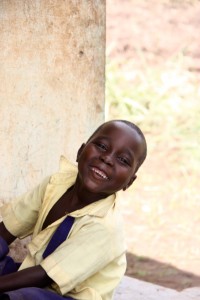 struggling in regards to the provision of quality learning and playing material and furniture. Another chal
struggling in regards to the provision of quality learning and playing material and furniture. Another chal
lenge is their lack of a clean water supply close to the school, as the closest well’s water is
polluted. Nevertheless, the positive and motivated spirit and attitude of people from
Nwoya Public Nursery School is without doubt inspiring. They truly want, and are trying their best, to give their children the best start possible! We are happy to be working and supporting communities like this and we hope you join us!
School #2: Koch Goma Nursery School
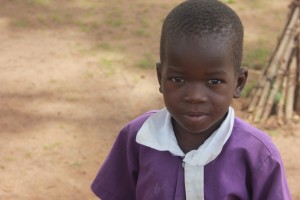 Located on the premises of Koch Goma Primary School, Koch Goma Nursery School is set in a beautiful location. The school grounds are well kept and swept daily; pink and orange flowers line the entrance of the school, the Ugandan and school flags ripple in the breeze, and inspiring slogans painted on wooden plaques are displayed throughout the school. As one can imagine, this school provides a wonderful learning environment for students- from the very youngest nursery pupils, to the class of P7 who will be taking their PLE exams later on this year, which will determine whether they may progress to secondary school.
Located on the premises of Koch Goma Primary School, Koch Goma Nursery School is set in a beautiful location. The school grounds are well kept and swept daily; pink and orange flowers line the entrance of the school, the Ugandan and school flags ripple in the breeze, and inspiring slogans painted on wooden plaques are displayed throughout the school. As one can imagine, this school provides a wonderful learning environment for students- from the very youngest nursery pupils, to the class of P7 who will be taking their PLE exams later on this year, which will determine whether they may progress to secondary school.
103 students are currently enrolled at the well-staffed Koch Goma Nursery School, which is served by four dedicated teachers led by the director Esterina: head-teacher Gloria, Stella, Gladys and Susan. Classes are held in a classroom block-kindly donated by the primary school- consisting of three small classrooms. The rooms are dark, and lack sufficient desks and chairs, so some children have to sit on the hard floor during classes. For this reason, the teachers try to bring the children outside into the fresh air and sunshine for activities and lessons whenever they can. In particular, the young pupils love competing with each other in running competitions!
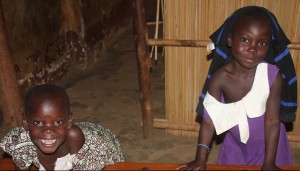 Within the classrooms, the teachers have proved to be inventive in creating their own learning materials. Through our Jumpstart! programme, we have been working with the teachers to make home-made posters made of brightly-coloured cardboard paper, and flash cards adorn the nursery’s walls. The teachers also make use of the local (and free) resources at their disposition- such as empty water bottles and soda lids- to ensure that lessons are dynamic and engaging for their young students. However, the children’s timetable is a well-rounded one, which also includes plenty of free-play, and a porridge break. For some children, this meal represents their main meal of the day and so they greatly enjoy the sweet, filling portion of porridge each morning. When the school day ends at 12pm, the children help to clean up the classrooms through sweeping and tidying away toys, so that it is clean and organized ready for another day of learning.
Within the classrooms, the teachers have proved to be inventive in creating their own learning materials. Through our Jumpstart! programme, we have been working with the teachers to make home-made posters made of brightly-coloured cardboard paper, and flash cards adorn the nursery’s walls. The teachers also make use of the local (and free) resources at their disposition- such as empty water bottles and soda lids- to ensure that lessons are dynamic and engaging for their young students. However, the children’s timetable is a well-rounded one, which also includes plenty of free-play, and a porridge break. For some children, this meal represents their main meal of the day and so they greatly enjoy the sweet, filling portion of porridge each morning. When the school day ends at 12pm, the children help to clean up the classrooms through sweeping and tidying away toys, so that it is clean and organized ready for another day of learning.
Gladys, a newly qualified ECD teacher who joined the school last year, teaches K3 and is currently working on five key learning areas with her pupils: the environment, religious education, sounds, numbers, and language. Gladys is passionate about Early Childhood Development, telling us that “it is important for the children to develop their minds; the  children who stay at home, instead of attending Nursery School, lack very basic knowledge, and they lack confidence amongst their peers, and adults. But being here, our pupils happily interact with others through singing songs and learning rimes; these activities are so important for their overall development.” As such, Gladys is confident that her pupils will be well-prepared to begin primary school next year.
children who stay at home, instead of attending Nursery School, lack very basic knowledge, and they lack confidence amongst their peers, and adults. But being here, our pupils happily interact with others through singing songs and learning rimes; these activities are so important for their overall development.” As such, Gladys is confident that her pupils will be well-prepared to begin primary school next year.
Indeed, the pupils are all energetic and eager to learn particularly through song and dance. Impressively, the students at Koch Goma Nursery School all know how to recite the alphabet, the vowels within the English language, the months of the year, and the days of the week; these achievements were all taught through fun songs, which the children sing  and dance to in the court- yard. It is therefore clear that the K1 students have made strong progress since beginning nursery school in February. The children have adjusted well to their new routine, and are enjoying participating in the activities which the school offers. Mildred, a student in K1, told us that “I like colouring; I don’t have pens or paper at home so I like coming to school to learn how to draw”.
and dance to in the court- yard. It is therefore clear that the K1 students have made strong progress since beginning nursery school in February. The children have adjusted well to their new routine, and are enjoying participating in the activities which the school offers. Mildred, a student in K1, told us that “I like colouring; I don’t have pens or paper at home so I like coming to school to learn how to draw”.
Supported by African Revival for several years, Koch Goma Primary School is an innovative centre of excellence, engaging in teacher networks and ensuring the retention of female students, through empowering girls and constructing girls’ washrooms. As such, we have every confidence that once the Nursery School children progress to Primary school, not only will they will be well-prepared to excel academically, but will be encouraged to pursue their studies – regardless of their gender – so that their future may be bright and bursting with possibility. Through Jumpstart! we hope to positively impact the lives of many young children in the Nwoya district of Northern Uganda for many, many years to come.
School #3: Purongo Hill Nursery!
 As its name suggests, Purongo Hill Nursery School is located on the top of a hill, off one of the dirt roads within northern Uganda’s Nwoya district; students may feel the burn walking up to the school, but they are awarded with lovely panoramic views over-looking the surrounding fields once they eventually reach the nursery! Situated on the same premises as Purongo Hill Primary School, the nursery block consists of three classrooms- one for each year of kindergarten: K1, K2, and K3.
As its name suggests, Purongo Hill Nursery School is located on the top of a hill, off one of the dirt roads within northern Uganda’s Nwoya district; students may feel the burn walking up to the school, but they are awarded with lovely panoramic views over-looking the surrounding fields once they eventually reach the nursery! Situated on the same premises as Purongo Hill Primary School, the nursery block consists of three classrooms- one for each year of kindergarten: K1, K2, and K3.
Like its students, Purongo Hill Nursery School is a young school, as it opened its doors for the very first time this year. As such, the staff are working extremely hard to establish the nursery as an excellent ECD centre. Currently, the school is almost completely unfurnished, and does not have any desks or chairs for the pupils. Instead, the children sit on the concrete floors during lessons. The only furnishings consist of blackboards in each classroom, a teacher’s desk, and several plastic chairs. Although pre-primary education is slowly gaining momentum in Uganda, most ECD centres have limited resources and finances, making it difficult for nurseries to truly thrive. However, although basic, the nursery’s white classrooms are large, and natural sunlight streams through the windows which automatically makes the rooms more attractive, and welcoming.
 As a newly established ECD centre, the first term proved to be a steep learning curve for the school’s three caregivers- Scovia, Jino and Jackline-, as they did not know much about Early Childhood Development. Although the teachers had been provided with a national learning framework to plan lessons, they felt out of their depth as they navigated the world of nursery teaching. For this reason, Scovia and Jino were selected to attend ECD training at Gulu Core PTC in February, and again at the beginning of May. During their training, sponsored by African Revival, Scovia and Jino were taught how to use the learning framework correctly, and learnt how to plan lessons, and establish daily routines for the children; these new skills have now been shared with their colleague, Jackline. Scovia told us: “I am more than happy that two of us are undergoing a certificate course at Gulu Core Primary Teachers’ College in Early Child Hood Development (ECD), courtesy of African Revival. To catch up and make the centre what it is, we took to making learning/ teaching materials after receiving training organized by African Revival. This took most of our time, but I am quite happy that we now know more from the training we received. I therefore guarantee you that our ECD centre will even do much better in term two and the other coming terms.”
As a newly established ECD centre, the first term proved to be a steep learning curve for the school’s three caregivers- Scovia, Jino and Jackline-, as they did not know much about Early Childhood Development. Although the teachers had been provided with a national learning framework to plan lessons, they felt out of their depth as they navigated the world of nursery teaching. For this reason, Scovia and Jino were selected to attend ECD training at Gulu Core PTC in February, and again at the beginning of May. During their training, sponsored by African Revival, Scovia and Jino were taught how to use the learning framework correctly, and learnt how to plan lessons, and establish daily routines for the children; these new skills have now been shared with their colleague, Jackline. Scovia told us: “I am more than happy that two of us are undergoing a certificate course at Gulu Core Primary Teachers’ College in Early Child Hood Development (ECD), courtesy of African Revival. To catch up and make the centre what it is, we took to making learning/ teaching materials after receiving training organized by African Revival. This took most of our time, but I am quite happy that we now know more from the training we received. I therefore guarantee you that our ECD centre will even do much better in term two and the other coming terms.”
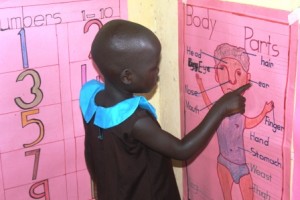 Indeed, when we first began working with the nursery, the white walls of the classrooms were completely bare. However, the teachers have been working with our ECD monitors to create vibrant learning materials- like posters and flashcards- which support the pupils’ learning, and help forge a bright and exciting learning environment associated with nursery education. The children, responsive to colours and textures, love these additions, and enjoy looking at all the pictures dotted around the classrooms! Their parents have also been impressed by the improved classrooms, and the children’s ability to read the words, and recognize the numbers on the posters.
Indeed, when we first began working with the nursery, the white walls of the classrooms were completely bare. However, the teachers have been working with our ECD monitors to create vibrant learning materials- like posters and flashcards- which support the pupils’ learning, and help forge a bright and exciting learning environment associated with nursery education. The children, responsive to colours and textures, love these additions, and enjoy looking at all the pictures dotted around the classrooms! Their parents have also been impressed by the improved classrooms, and the children’s ability to read the words, and recognize the numbers on the posters.
Not only has the children’s academic performance improved, but the children are growing in confidence, and are gaining invaluable social skills. When we met the children in February, many were nervous and shy, but what a difference a term can make! Jino recently told us that “when the pupils came to the centre, their knowledge was very weak. By the end of the term, the pupils could confidently sing rhymes and interact well among themselves. Many of the children could cry whenever they were brought to the centre in the morning, but by end of term, they were used to the school environment”.
During Purongo Hill’s first fabulous end of term open day, parents were able to admire the progress of their young children. As the children sang, danced, and showed their work to parents and visitors, it became clear that the children have really settled into the school environment, and are learning quickly. Thanks to the very visible improvements to the school, the children’s parents are eager to support the school through attending school meetings, and contributing ideas for school development, and have shown a real interest in their children’s early childhood development. Sarah, who is the parent of Emmanuel, a K1 student, told us: “I have really enjoyed visiting my son’s classroom, and actually seeing what he is learning. I can see now just how much the teachers do for him. I can tell that nursery school has been good for Emmanuel, because at home, he is always telling me about the things he is learning; he now knows the names of most household items”.
The teachers have been working very hard to provide the best possible start in life for their students, and have been encouraged by the parents’ appreciation for all they have done so far, which is spurring them on to continue renewing their efforts! In fact, most parents in the community have now rated Purongo Hill Nursery School as the best in the locality! As such, the school management is expecting a surge in enrolment during the next intake of students; the future looks bright and exciting at this nursery! As one of Jumpstart!’s partner nurseries, we will be supporting Purongo Hill for the next two and half years, as we work together to transform the nursery through building the teachers’ skills, providing learning materials, and furniture. Our hope is that through providing excellent nursery education, the children of Purongo Hill will develop the cognitive, emotional, physical, social and academic skills needed to excel both in their studies, and in life.
School #4: Welcome to Lacek Community School!
 Lacek Community School is remote, located in the midst of seemingly never-ending fields of high grass, which even cover most of the bumpy dirt road leading up to the school. With the help of Save the Children, the school was founded in 2009. The organisation financed two classroom blocks. Unfortunately, the bricks and cement have crumbled away, leaving big holes in the walls, exposing the classrooms and the basic furnishings to various weather conditions. As a result, desks and chairsare only available for a few pupils. The majority of students sit on the floor, eagerly trying to catch all the informationbeing taught. Furthermore, the two classrooms blocks, consisting of four classrooms, are clearly not sufficient for a school which aims to provide education for kindergarten pupils as well as primary students from P1 to P7. Therefore, the community sought toconstruct additional buildings. However, with their limited resources, they were only able to create one fully completed local hut, which is reserved for the nursery school; the other three structures consist of a thatched shelter aiming to at least provide some shade and protection.
Lacek Community School is remote, located in the midst of seemingly never-ending fields of high grass, which even cover most of the bumpy dirt road leading up to the school. With the help of Save the Children, the school was founded in 2009. The organisation financed two classroom blocks. Unfortunately, the bricks and cement have crumbled away, leaving big holes in the walls, exposing the classrooms and the basic furnishings to various weather conditions. As a result, desks and chairsare only available for a few pupils. The majority of students sit on the floor, eagerly trying to catch all the informationbeing taught. Furthermore, the two classrooms blocks, consisting of four classrooms, are clearly not sufficient for a school which aims to provide education for kindergarten pupils as well as primary students from P1 to P7. Therefore, the community sought toconstruct additional buildings. However, with their limited resources, they were only able to create one fully completed local hut, which is reserved for the nursery school; the other three structures consist of a thatched shelter aiming to at least provide some shade and protection.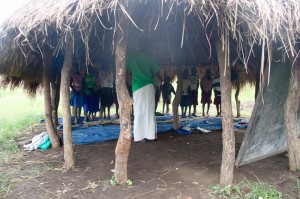
As this school does not receive any financial support from the government, the community’s commitment to provide a place for their children to learn is inspiring – without it, most of the children would not be able to receive any education as governments schools are too far away for the children to reach. Unfortunately, their financial abilities are restricted and therefore, the school clearly struggles to make ends meet – learning materials and furniture are scarce, and teachers often go unpaid.
Therefore, all the more impressive is the work done by the nine teachers of Lacek Community School as they don’t fail to see the importance of the work they are doing – Sunday, the headteacher and one of the ECD teachers, explained to us:
“This school is helping these learners to get the quality education that they almost listen from other people. It is actually bringing this quality education to form hard-to-reach areas, like this. This place is not easy to reach, and not even for Ugandan. Other learners have not even been in school, and this school is helping them to acquire some knowledge. The neighbouring school from here is almost 4-5km away of which they cannot even manage to walk to those schools.”
Sunday was only 19 years old when the community chose him to become the headteacher. After two years, he has expanded the primary school from P3 to P7, seeing the need for advanced levels of education in the community. As an ambitious young man, he envisions a brighter future for the school, and is hoping to find funding for the construction of classrooms, teacherhouses, furniture and quality learning and playing materials.
 Lacek Community School’s nursery has 64 children. Some of them are even younger than 3 years old. Furthermore, as they only have one ‘hut’ at their disposal, the K1 to K3 classes are often taught together. These are of course not ideal learning conditions, but with a well-rounded timetable, the ECD teachers are clearly determined to do their best to offer these children an excellent start in life every day despite the challenges they face. Therefore, they involve a lot of activities that the children enjoy in the daily routine – for example, Proscovia (seen in the next photo) tells us that “they like playing, and in some ways to what is related to teaching; and citing poems and rhymes related to what you are teaching.” As you can see in the timetable, they try to make sure that it is full of singing, rhyming and dancing!
Lacek Community School’s nursery has 64 children. Some of them are even younger than 3 years old. Furthermore, as they only have one ‘hut’ at their disposal, the K1 to K3 classes are often taught together. These are of course not ideal learning conditions, but with a well-rounded timetable, the ECD teachers are clearly determined to do their best to offer these children an excellent start in life every day despite the challenges they face. Therefore, they involve a lot of activities that the children enjoy in the daily routine – for example, Proscovia (seen in the next photo) tells us that “they like playing, and in some ways to what is related to teaching; and citing poems and rhymes related to what you are teaching.” As you can see in the timetable, they try to make sure that it is full of singing, rhyming and dancing!
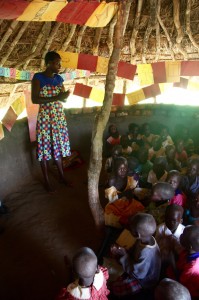 Additionally, in spite of the poor lighting, the three ECD teachers try their best to make their little modest hut as colourful and as entertaining as possible, by hanging up hand-drawn posters that can be used as visual learning aids. They have also learnt how to create learning and playing materials out of local materials to compensate for expensive manufactured ones:
Additionally, in spite of the poor lighting, the three ECD teachers try their best to make their little modest hut as colourful and as entertaining as possible, by hanging up hand-drawn posters that can be used as visual learning aids. They have also learnt how to create learning and playing materials out of local materials to compensate for expensive manufactured ones:
“We have the temporary ones that we have created; they are in that box we left in the classroom. I was trained how to make it. – like there is one that I call models. It is made out of leafs, or cassava, the potatoes, I can make it from avocado, any fruits… I use the fruit itself to make it the temporary ones. I remove the seed, I fix, more stuff inside then it becomes hard.” (Sunday)
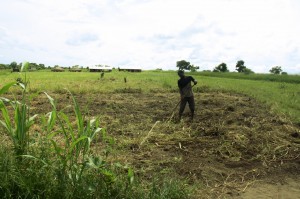 However, some challenges are harder to overcome than others. Most of the kids come to school without having eaten breakfast and last month, the community struggled to provide porridge for the little ones in the nursery. As result, they are of course hungry and cannot perform well. The headteacher and the dedicated community are trying their best to change this. However, as most parents work as farmers, their income is dependent on seasonal harvests – which are nowadays often rather unpredictable due to climate change. This is where the VSLA (Village Saving and Loan Association) training by African Revival has become crucial. As part of this initiative, parents contribute money to a joint fund which they can borrow from if needed. In addition, parents have started to prepare some parts of the school grounds to plant cabbage for midday meals.
However, some challenges are harder to overcome than others. Most of the kids come to school without having eaten breakfast and last month, the community struggled to provide porridge for the little ones in the nursery. As result, they are of course hungry and cannot perform well. The headteacher and the dedicated community are trying their best to change this. However, as most parents work as farmers, their income is dependent on seasonal harvests – which are nowadays often rather unpredictable due to climate change. This is where the VSLA (Village Saving and Loan Association) training by African Revival has become crucial. As part of this initiative, parents contribute money to a joint fund which they can borrow from if needed. In addition, parents have started to prepare some parts of the school grounds to plant cabbage for midday meals.
Jumpstart! is trying to support Lacek Community School through facilitating further community sensitisation and professional teacher development, which may include refresher training, guidance on making teaching and learning materials and formal teacher training at the local ECD centre for one of the teacher training. Sunday has especially appreciated one of the refresher workshop:
“The knowledge I have acquired in the past week thanks to African Revival is more unique than other courses. The tutors, who have been doing the training, have equipped us with useful skills in lesson planning, and devising work-plans to cover the curriculum. It has been most helpful. I have also learnt how to create good classroom displays and how to be more creative with playing materials – now I know what local materials I can use as learning tools”.
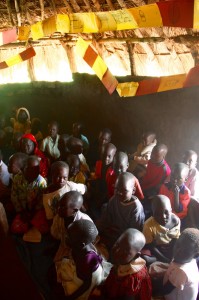 In addition, the project also aims at helping the school in the provision of an engaging and adequate learning environment through the provision of teaching and learning materials. We hope to continuesupporting this inspiring community and teachers to enable the little pupils realise their full potential one they – as it is thanks to their dedication and commitment that Sunday is able to tell us about the positive development the children are undergoing: “At the beginning of the term, many of them do not know how to read, how to count numbers and how to differentiate numbers. And now, they can, some can do that and that is how I can see that they are developing. “
In addition, the project also aims at helping the school in the provision of an engaging and adequate learning environment through the provision of teaching and learning materials. We hope to continuesupporting this inspiring community and teachers to enable the little pupils realise their full potential one they – as it is thanks to their dedication and commitment that Sunday is able to tell us about the positive development the children are undergoing: “At the beginning of the term, many of them do not know how to read, how to count numbers and how to differentiate numbers. And now, they can, some can do that and that is how I can see that they are developing. “
Profile #5: Koch Lila Nursery School
Koch Lila ECD Centre – situated in northern Uganda’s Nwoya district – is another one of our partner Jumpstart nurseries; we have been working together since February 2015 to transform the centre into a thriving learning environment for its 57 young students.
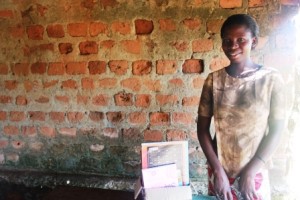 With nursery education still building momentum in Uganda, Koch Lila-like many other rural nurseries – is very basic, both in terms of infrastructure and learning materials. However, that doesn’t mean that the school doesn’t positively impact its pupils; there is much more than meets the eye. Once you look beyond the simple structures, the potential of this centre is all too apparent, thanks to the dedication of the nursery’s head teacher, Katherine (photo), who recently qualified as a ECD teacher, and has been working hard to implement her knowledge into improving the teaching quality at the nursery.
With nursery education still building momentum in Uganda, Koch Lila-like many other rural nurseries – is very basic, both in terms of infrastructure and learning materials. However, that doesn’t mean that the school doesn’t positively impact its pupils; there is much more than meets the eye. Once you look beyond the simple structures, the potential of this centre is all too apparent, thanks to the dedication of the nursery’s head teacher, Katherine (photo), who recently qualified as a ECD teacher, and has been working hard to implement her knowledge into improving the teaching quality at the nursery.
The ECD centre is currently spread out across the grounds of Koch Lila Primary School, located 15km off the main road from Koch Goma sub-country leading to the Nwoya district head-quarters. The K1 pupils’ “classroom” is outside, under a hand-made thatched shelter; the 14 children sit on a plastic blue mat as their teacher, Katherine, conducts their lessons in front of a large piece of blackboard. Currently, the children are learning to recognize, and form letters- which they practice carefully in their exercise books, making sure they keep their letters within the ruled lines. Although this learning environment may seem rudimentary, the K1 learning space actually represents a positive step for the school. Several months ago, the K1s were taught together with K2 pupils, which was not conductive to productive learning particularly for the youngest children who require a little more attention and support. As such, although the K1 students are now taught in a more basic space, they now have their own teacher – Katherine – who can focus all her time and energy on their lessons, and the children are less distracted by the activities of their older peers.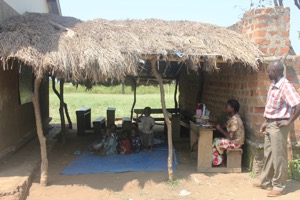
The K2s’ classroom is a small thatched hut. When we first began working with the ECD, this classroom was bare, and empty. However, K2 teacher Lillian, whom we have sponsored through ECD training, has re-arranged her classroom so that her pupils now sit in groups, known as “island sitting”. Lillian tells us that the children like to “participate in groups; they do their exercises together- they like it, working in teams. So, I have introduced this sitting arrangement which also helps their socialisation.” The bare walls made of exposed bricks are now simply a back-drop for the bright, home-made learning posters which Katherine has been making during our workshops. Lillian has also hung strings of letters, and numbers across the classroom to support her pupils’ learning. These resources seem to be effective as the children can now confidently sing their ABCs perfectly; they don’t just know the song, but they point to the appropriate flash card as they go through the letters! Lillian is delighted at her pupils’ tremendous progress, which she attributes in part to her new-found skills as a teacher:
“After receiving training facilitated by African Revival, teaching became easy because I can now interpret the Learning Frame Work, I can assess easily which competences matches which age bracket. I also learnt how to produce learning materials which has enabled pupils to learn easily and better”.
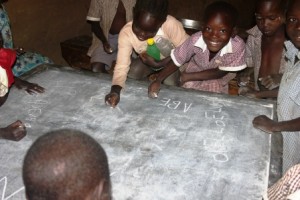 Finally, the nursery’s K3 pupils’ lessons take place in a large hut which also serves as the school’s church; although dark, there is plenty of room for the 27 students to run around and interact with one another. The pupils are taught by the nursery school’s head-teacher, Katherine, who joined the school in 2013. Although Katherine’s pupils can now all read and write their own names, the children are not just developing well academically, but also as individuals. The first thing which we notice about these pupils is that they are bright-eyed and confident, as they work and play together. Katherine has nurtured a learning environment where children can be themselves, and feel assured that their contributions to lessons- whether right or wrong – are of value. In fact, these hard-working children have overcome several challenges in order to succeed at school; notably, their tables and chairs are meant for primary school pupils, and are therefore too big for their small bodies. As such, completing work- like writing practice-requires them to stand up, and hunch over the tables. However, as part of our Jumpstart programme, we will be working with our partner nurseries in the coming months to ensure that the centres are equipped with age-appropriate furniture to enhance the pupils’ learning experience.
Finally, the nursery’s K3 pupils’ lessons take place in a large hut which also serves as the school’s church; although dark, there is plenty of room for the 27 students to run around and interact with one another. The pupils are taught by the nursery school’s head-teacher, Katherine, who joined the school in 2013. Although Katherine’s pupils can now all read and write their own names, the children are not just developing well academically, but also as individuals. The first thing which we notice about these pupils is that they are bright-eyed and confident, as they work and play together. Katherine has nurtured a learning environment where children can be themselves, and feel assured that their contributions to lessons- whether right or wrong – are of value. In fact, these hard-working children have overcome several challenges in order to succeed at school; notably, their tables and chairs are meant for primary school pupils, and are therefore too big for their small bodies. As such, completing work- like writing practice-requires them to stand up, and hunch over the tables. However, as part of our Jumpstart programme, we will be working with our partner nurseries in the coming months to ensure that the centres are equipped with age-appropriate furniture to enhance the pupils’ learning experience.
We are all delighted to see the significant improvements to the nursery school already, but perhaps one of the most exciting developments for the children within the nursery school lies within a cardboard box outside the K2 classroom: toys which were made by the teachers using local and recycled materials during our work-shops! An empty oil container, several bottle tops, some string… and voila! A pull-along toy car! Ensuring that 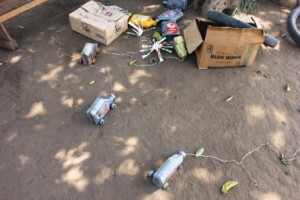 nursery children have plenty of time for creative free-play is a fundamental aspect of promoting a child’s early development, and so it is wonderful to see children enjoying playing with these new toys during break-times. At African Revival, our goal is positively impact nurseries in a sustainable manner, and so by developing caregivers’ soft skills, and introducing low-cost learning and playing materials created using local and recycled resources means that many, many more nursery children will be able to benefit from these skills, and materials in the coming years.
nursery children have plenty of time for creative free-play is a fundamental aspect of promoting a child’s early development, and so it is wonderful to see children enjoying playing with these new toys during break-times. At African Revival, our goal is positively impact nurseries in a sustainable manner, and so by developing caregivers’ soft skills, and introducing low-cost learning and playing materials created using local and recycled resources means that many, many more nursery children will be able to benefit from these skills, and materials in the coming years.
The primary school’s deputy head-teacher George told us that the school leadership is extremely encouraged by the nursery children’s progress. George is convinced that once the children progress to primary school, they will be well-prepared to succeed academically in comparison to children who have not had the opportunity to attend an 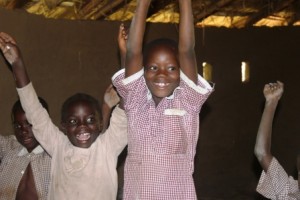 ECD centre. Although Koch Lila Nursery School is relatively small, our hope is that, through its remarkable young pupils, the local community will be more convinced than ever of the value of nursery education, leading to increased enrolment figures- meaning that more children at Koch Lila receive their Jumpstart towards the bright future they deserve.
ECD centre. Although Koch Lila Nursery School is relatively small, our hope is that, through its remarkable young pupils, the local community will be more convinced than ever of the value of nursery education, leading to increased enrolment figures- meaning that more children at Koch Lila receive their Jumpstart towards the bright future they deserve.
Profile #6: Welcome to Wilacic Nursery School!
Wilacic’s ECD Centre is one of our Jumpstart! partner nurseries, which was established in 2010 by the pro-active local community, who wanted to provide their young children with nursery education. Currently, 89 pupils are enrolled in the nursery: 48 pupils in K1, 18 in K2, and 23 in K3. 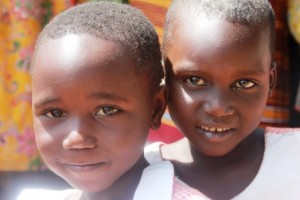
Located at Wilacic Primary School, the community nursery falls just within the Nwoya district, but is situated just off the main dirt road which leads straight to nearby Gulu Town. Armed with exercise books and pencil cases, most children walk several kilometres each day along this busy road to reach class. To ensure their safety, the school children have an un-official “buddy system”: pupils walk to school with their neighbours, friends, or siblings as a large group, and make sure that the same group all walk home together at the end of the day. Often, the younger nursery pupils will get piggy back rides part of the way from their older brothers and sisters.
One of these young students is K2 pupil Babra. Every morning, Babra walks 3km along the dusty country roads with her older brothers and sisters to attend the pre-primary school. Often, Babra will meet her friends along the way, and will continue her journey skipping and playing with her companions until they reach their classroom. In spite of the long walk, Babra, dressed in her smart red and white checked school uniform, looks the part for a new day of learning. Babra’s favourite meal is porridge, which is handy because with our encouragement, parents now contribute millet and sugar so that teachers can serve a break-time meal of porridge to their kindergarten students every day. This school meal has ensured that pupils have sufficient energy and concentration levels to engage in classroom activities after travelling considerable distances under the hot sun to attend school. The children really enjoy the warm, sweet meal which re-energizes them for more learning in their classrooms, and games! Indeed, the school has plenty of open space for the children to run around, meaning that the possibilities for break time games are endless! Unsurprisingly, football is often the favoured pastime- although the students often have to improvise for a ball, using balled up leaves secured with elastic bands.
Although pre-primary education is slowly gaining momentum in Uganda, most ECD centres have limited resources and finances, making it difficult for nurseries to truly thrive. Community schools in particular, such as Wilacic ECD, require a great deal of commitment and financial sacrifice from parents and community members to keep the school open. As such, when we began working with Wilacic ECD, its classrooms were very basic: the two rooms – one for K1, one for the combined K2 and K3 class – which make up the nursery school were dark and small, and lacked the materials needed to fully engage children, and facilitate their learning. However, we have been working closely with the 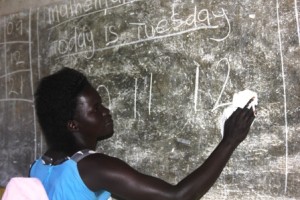 school’s teachers – Ajok Lilian (photo) , Apiyo Juliana and Akot Kevin – through our Jumpstart! programme to support the nursery in becoming a vibrant and successful nursery, where children can blossom into well-rounded individuals who are fully prepared for primary school. We have sponsored Ajok Lilian and Apiyo Juliana to attend professional training at Gulu Core PTC so they have now gained the essential skills necessary to nurture their pupils’ social, cognitive, emotional, physical and intellectual development. The teachers are motivated, full of energy and passionate about their pupils, so they have been wonderful to have partner with!
school’s teachers – Ajok Lilian (photo) , Apiyo Juliana and Akot Kevin – through our Jumpstart! programme to support the nursery in becoming a vibrant and successful nursery, where children can blossom into well-rounded individuals who are fully prepared for primary school. We have sponsored Ajok Lilian and Apiyo Juliana to attend professional training at Gulu Core PTC so they have now gained the essential skills necessary to nurture their pupils’ social, cognitive, emotional, physical and intellectual development. The teachers are motivated, full of energy and passionate about their pupils, so they have been wonderful to have partner with!
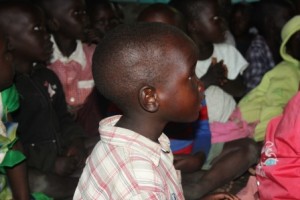 Their beautifully-behaved pupils sit together in rows on benches, facing the large blackboards at the front of the classrooms, where the majority of teaching takes place. With their teachers’ encouragement, children often come up to the blackboard to answer questions. Although the teachers pepper their teaching with plenty of singing and dancing, this formal learning style is not appropriate for very young children. Instead, little ones are responsive to activities, games, and are stimulated by bright colours and textures. With this in mind, we have been working with the teachers to create visually stimulating posters and flash cards to promote the children’s learning, and transform the dark classrooms into an exciting place to learn. Using a little creativity and imagination, we have sought to introduce materials which are cheap to produce, and optimize the use of local resources. For example, our ECD monitors have helped the teachers to use items from the environment as learning resources; for example, different varieties of dry beans and peas are easy to collect, and can be used as counters, contribute to a texture box, and help children learn about different food groups.
Their beautifully-behaved pupils sit together in rows on benches, facing the large blackboards at the front of the classrooms, where the majority of teaching takes place. With their teachers’ encouragement, children often come up to the blackboard to answer questions. Although the teachers pepper their teaching with plenty of singing and dancing, this formal learning style is not appropriate for very young children. Instead, little ones are responsive to activities, games, and are stimulated by bright colours and textures. With this in mind, we have been working with the teachers to create visually stimulating posters and flash cards to promote the children’s learning, and transform the dark classrooms into an exciting place to learn. Using a little creativity and imagination, we have sought to introduce materials which are cheap to produce, and optimize the use of local resources. For example, our ECD monitors have helped the teachers to use items from the environment as learning resources; for example, different varieties of dry beans and peas are easy to collect, and can be used as counters, contribute to a texture box, and help children learn about different food groups.
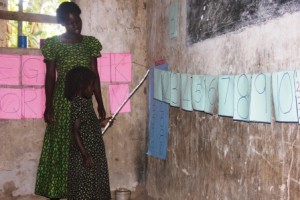 We will be working with Wilacic for the next two and a half years, but the previously bare classes are already looking much brighter and conductive to learning through these changes. Learning posters are now dotted around the classrooms, strings of alphabet flash cards are strung across the rooms, and the children’s drawings are proudly displayed by the blackboard. The children have been rather enthralled by these new materials; the teachers tell us that their pupils often sit quietly just looking at the learning posters, so they are learning passively without even realising! The school’s head teacher Lillian is thrilled with these improvements, and is confident that the children’s development and academic progress will subsequently improve significantly. Indeed, through our Jumpstart! programme, we hope to help students like Babra develop the physical, social, mental, and cognitive skills which will enable her to blossom into a well-rounded individual, full of confidence that she can achieve anything she puts her mind to.
We will be working with Wilacic for the next two and a half years, but the previously bare classes are already looking much brighter and conductive to learning through these changes. Learning posters are now dotted around the classrooms, strings of alphabet flash cards are strung across the rooms, and the children’s drawings are proudly displayed by the blackboard. The children have been rather enthralled by these new materials; the teachers tell us that their pupils often sit quietly just looking at the learning posters, so they are learning passively without even realising! The school’s head teacher Lillian is thrilled with these improvements, and is confident that the children’s development and academic progress will subsequently improve significantly. Indeed, through our Jumpstart! programme, we hope to help students like Babra develop the physical, social, mental, and cognitive skills which will enable her to blossom into a well-rounded individual, full of confidence that she can achieve anything she puts her mind to.
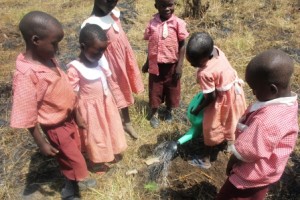 To address the issue of climate change, we recently held a tree-planting ceremony at the nursery school where teachers, parents and pupils planted a variety of seedlings. Just as the young seedlings need care and commitment to grow into strong, healthy trees, we hope that our Jumpstart! pupils at Wilacic will grow up to love learning, and enjoy success as empowered adults.
To address the issue of climate change, we recently held a tree-planting ceremony at the nursery school where teachers, parents and pupils planted a variety of seedlings. Just as the young seedlings need care and commitment to grow into strong, healthy trees, we hope that our Jumpstart! pupils at Wilacic will grow up to love learning, and enjoy success as empowered adults.
Thank you for your support!
Happy 6 Month Jumpstart! Anniversary!

